Elizabeth Holmes (née Emra)
1804 to 1843
A Country Parson’s Daughter
"Sit down with me amongst the beautiful purple heath, visited by the wild bees, and the blue butterflies; and breathe the fresh air of our rugged hill, and look on the fair extended prospect."
Elizabeth Emra, or ‘Little Elizabeth’, lived in St George from the age of four until around a year before her untimely death at the age of only 38. She was the author of “Scenes in our
Parish” which was first published in 1830. The book includes descriptions of the area as it then was, including a reference to "the barren and quarried hill, with its yellow spots of gorse and broom, and its purple shade of heath" – which remains a good description of Troopers Hill to this day.

The Emra Family
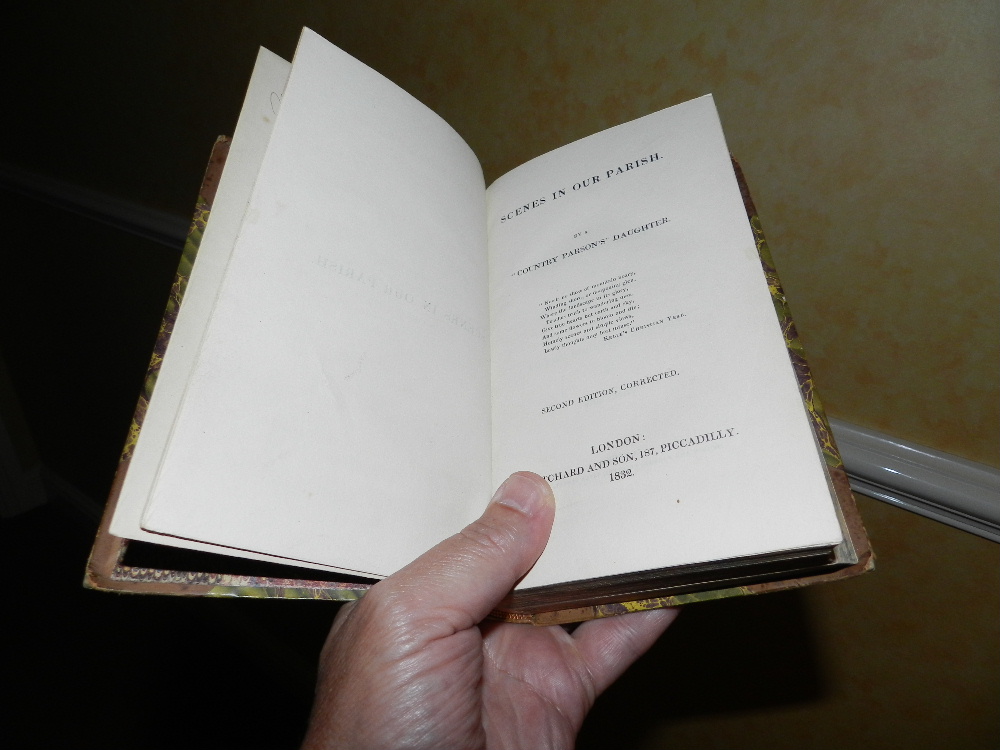 Elizabeth's father was Rev John Emra, vicar at St George Church from 1809-1842. According to a biographical sketch of Elizabeth's son first published in 1877 'the Rev. John Emra, vicar of St George's, Bristol, was the son of a slave-owner, a native of the Island of St Christopher [St Kitts], West Indies and the family was supposed to be of Spanish extraction'.
Elizabeth's father was Rev John Emra, vicar at St George Church from 1809-1842. According to a biographical sketch of Elizabeth's son first published in 1877 'the Rev. John Emra, vicar of St George's, Bristol, was the son of a slave-owner, a native of the Island of St Christopher [St Kitts], West Indies and the family was supposed to be of Spanish extraction'.
Elizabeth's mother was Elizabeth Bastone Blake, the only child of Francis Blake of Minehead, who died in 1803 leaving John & Elizabeth a significant inheritance.
Rev John Emra and Elizabeth Bastone married in 1795, they had 11 children (two died as infants) with the youngest born in St George in 1811.
Elizabeth was not the only author in the family; her sisters Martha and Lucy as well as her brother, John, all had books published. However, none of these seem to have had the success of Scenes in our Parish, which was published in the United States as well as England and had several reprints. As you might expect of the daughters and son of the Parson, much of the text & many of the poems have a religious theme.
After her death, Martha, Elizabeth's oldest sister wrote a description of her life. It was first published as 'A sister's record, or, Memoir of Mrs. Marcus H. Holmes' and then as an introductory chapter in later editions of Scenes in our Parish.
The memoir is often attributed to another sister, Lucy Emra, but it concludes with 'CANTERBURY January 1844' which indicates that it was more likely written by Martha, who was living at Canterbury at that time. This is confirmed by a later book by Martha stating that it was by the author of 'A Sister's Record'.
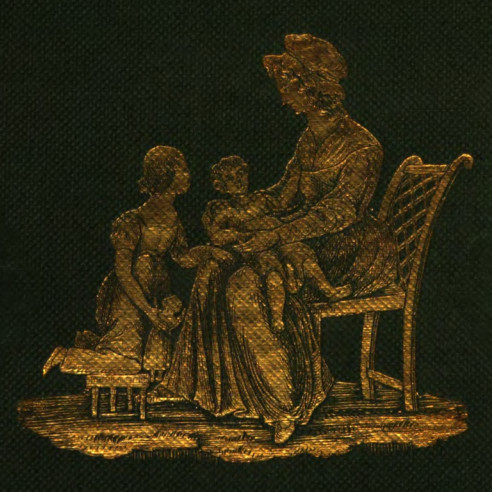 Martha, had also published a book in 1840, ‘Recollections of Childhood or Sally the faithful nurse’ under the pseudonym ‘Primogenita’ – reflecting the fact that she was the oldest child. This book describes the life of the family as her father served at different chuches as Curate and then in St George as vicar. The book is available on Google Books or can be purchased as a reproduction.
Martha, had also published a book in 1840, ‘Recollections of Childhood or Sally the faithful nurse’ under the pseudonym ‘Primogenita’ – reflecting the fact that she was the oldest child. This book describes the life of the family as her father served at different chuches as Curate and then in St George as vicar. The book is available on Google Books or can be purchased as a reproduction.
Special Collections, Princeton University Library in the United states, also holds a copy of Martha's book. The copy is enlarged by inlaying printed leaves in larger (24 cm.) blank leaves, and extra-illustrated with drawings, watercolors, and ms. poems and letters.
The book has note on leaf before title leaf: "Presented to Mrs. Elizh. Pople by Miss Frances Emra, in memory of her sister, Mrs. Lucy Croggan, who compiled this book with the marginal notes. And given by the said Mrs. Elizh. Pople to her cousin Mrs. Elizh. Tabitha Thomas.".
This book was digitized in 2022, and is available to view and download from the Library's catalog record. To download the entire volume as a PDF, navigate to the the download icon in the lower left-hand corner of the viewer.
A copy of another extra-illustrated version of the book is held in the Somerset Archive (ref
DD/UK/58) presumably put
together by a member of the family (perhaps also Lucy). This copy has many colour illustrations that are not included in the Princeton copy.

Elizabeth Emra
From her sisters' books and various official records we have put together much of Elizabeth's life story. Sadly, despite members of her family and her husband being talented artists, we have never found any drawing of her.
Elizabeth was born on 20th November 1804 in Bristol, when her father was Curate at St Paul's; as described above she was part a large family. A few months later the family moved to Yatton when her father became curate there. After the move to St George Elizabeth continued to live with her parents in the Vicarage until she married.
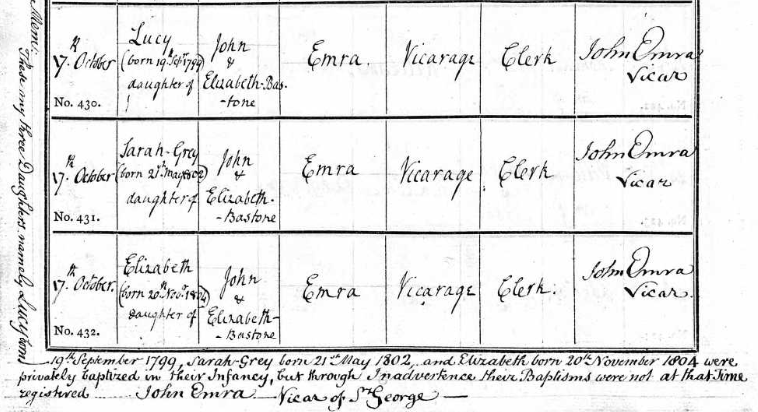 Elizabeth's baptism was recorded by her father on 17th October 1815, at the same time as her two sisters who had also been born while the family was living in Bristol; John Emra added a note to the register - "Memo: These my three Daughters, namely Lucy born 19th September 1799, Sarah-Grey born 21st May 1802, and Elizabeth born 20th November 1804 were privately baptized in their infancy, but through inadvertence their Baptisms were not at that time registered"
Elizabeth's baptism was recorded by her father on 17th October 1815, at the same time as her two sisters who had also been born while the family was living in Bristol; John Emra added a note to the register - "Memo: These my three Daughters, namely Lucy born 19th September 1799, Sarah-Grey born 21st May 1802, and Elizabeth born 20th November 1804 were privately baptized in their infancy, but through inadvertence their Baptisms were not at that time registered"
Elizabeth survived contracting smallpox but otherwise appears to have had a happy and
healthy childhood. As she grew up she increasingly involved herself with
trying to help the poor of the Parish.
Elizabeth's youngest sibling, her brother, Henry, died in a boating accident at Oxford in 1829, aged 18, and this is what she refers to at the beginning and end
of the chapter entitled ‘The Strawberry Feast’, which was written exactly a year later. It appears that he drowned while 'amusing himself on a skiff upon the river Isis, near Worcester college [Oxford], of which he had recently entered as a member'.
Elizabeth married the artist Marcus Henry Holmes on 12th July 1833. Marcus had been born in Bristol in 1803, he was educated at Bristol Grammar School and then became a student at the Royal Academy.
Marcus Holmes’s father was also an artist, George Holmes. George and his wife were Irish, they had moved to Bristol in 1802. Marcus’s mother died shortly after his birth, but his father later remarried, to a Miss Anstey of Devizes and had three more children. There is more about the Holmes family in a biographical sketch of Elizabeth Emra's second son (John, the author ‘Emra Holmes’).
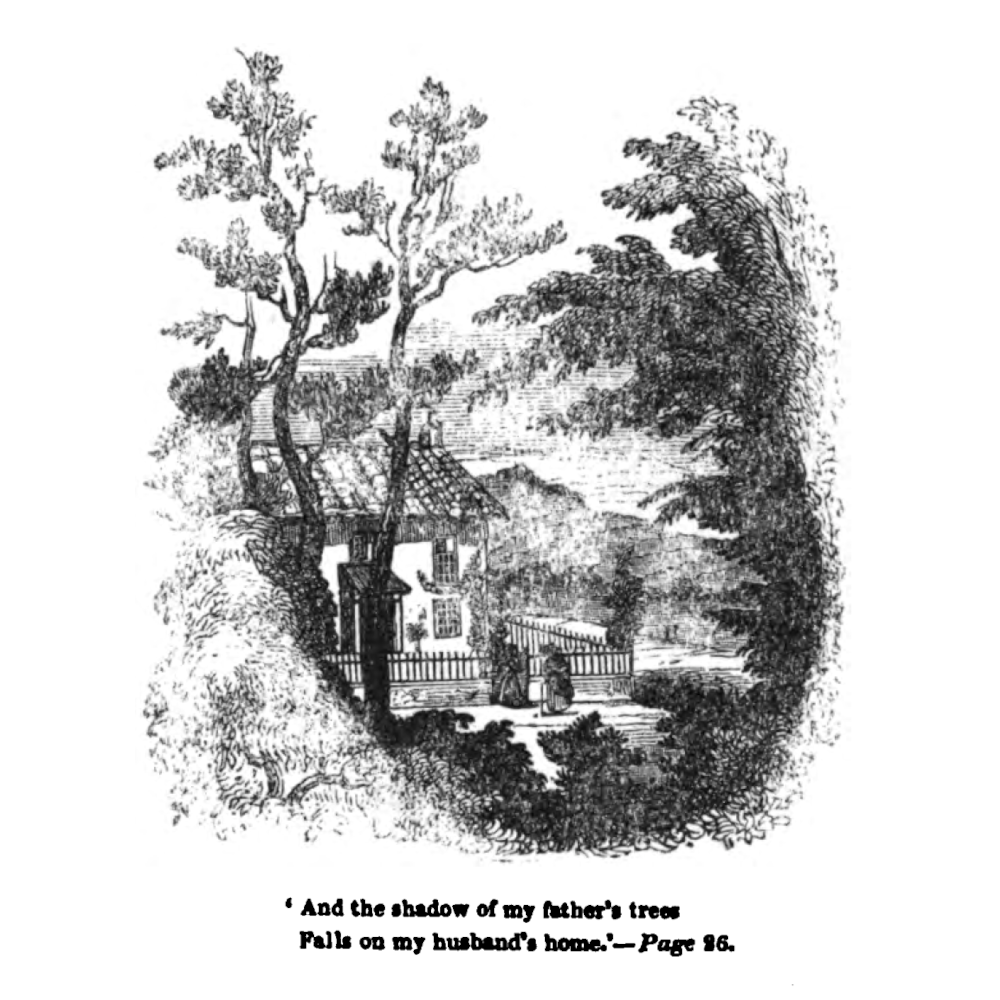 After their marriage Elizabeth and Marcus lived in ‘Homefield Cottage’
next to the Church and the vicarage; "the shadow of my father's trees Fall on my husband's home". Her first child, a girl, was born on 6th July 1834. One of Elizabeth's children died as an infant (John at only 2 days old in August 1838), but by the time of the 1841 census she and Marcus were living at Homfield with five children, Ann (aged 6), Henry (5), Agnes (3), John Emra (2) & Herbert (5 months).
After their marriage Elizabeth and Marcus lived in ‘Homefield Cottage’
next to the Church and the vicarage; "the shadow of my father's trees Fall on my husband's home". Her first child, a girl, was born on 6th July 1834. One of Elizabeth's children died as an infant (John at only 2 days old in August 1838), but by the time of the 1841 census she and Marcus were living at Homfield with five children, Ann (aged 6), Henry (5), Agnes (3), John Emra (2) & Herbert (5 months).
Elizabeth's mother had died on 24th April 1837 and this was followed by the death of her father, who was still serving as Vicar of St George after 33 years, at the age of 73 on 19th September 1842. Following her father's death, Elizabeth and the family no longer had access to the vicarage and its garden next to their house - Elizabeth wrote a poem 'On Laying Aside My Latch Key of the Vicarage Garden'. In December 1842, Elizabeth and her family (now 6 children, Marion was born earlier that year) moved to Westbury Hill (Redland/Westbury-on-Trym), 'within a short walk of her sisters' new residence'.
Within a year of the move, on 10th October 1843, Elizabeth died just a few days after the birth of
her own ‘little Elizabeth’ her eighth child. Elizabeth was laid to rest 'in her father's tomb, beside her loving mother, and the young brother who had found his early sepulchre there so many years before'.
Elizabeth's husband, Marcus Holmes, continued to live in Westbury with their children and is recorded there with his four daughters and youngest son in the 1851 census. Marcus died in January 1854, at Minehead (though his will written in September 1853 has his residence as Westbury). After their father's death the youngest children continued to live in Westbury with Elizabeth's sisters.
A summary of Elizabeth's life, together with a listing of Elizabeth's published works, is available as a pdf to download. There is also a second document with more details of Elizabeth's family, including her children, her husband Marcus and his parents and half-sister.

Portraits of Rev John & Elizabeth Emra
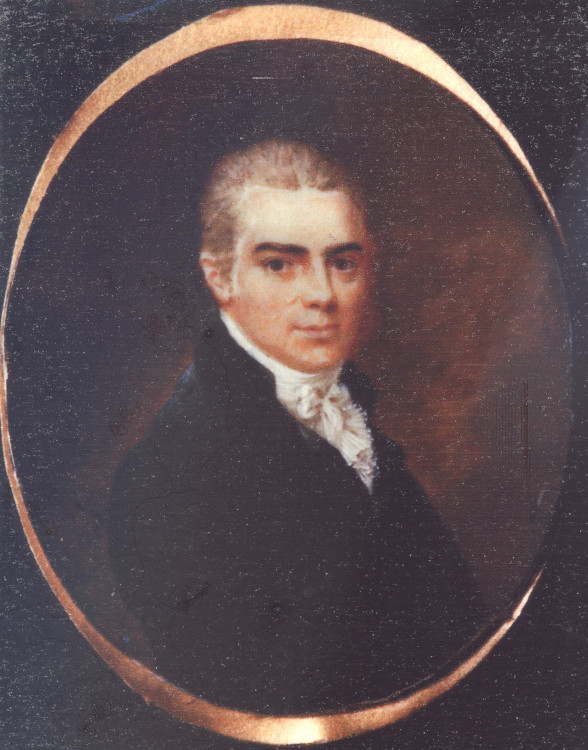
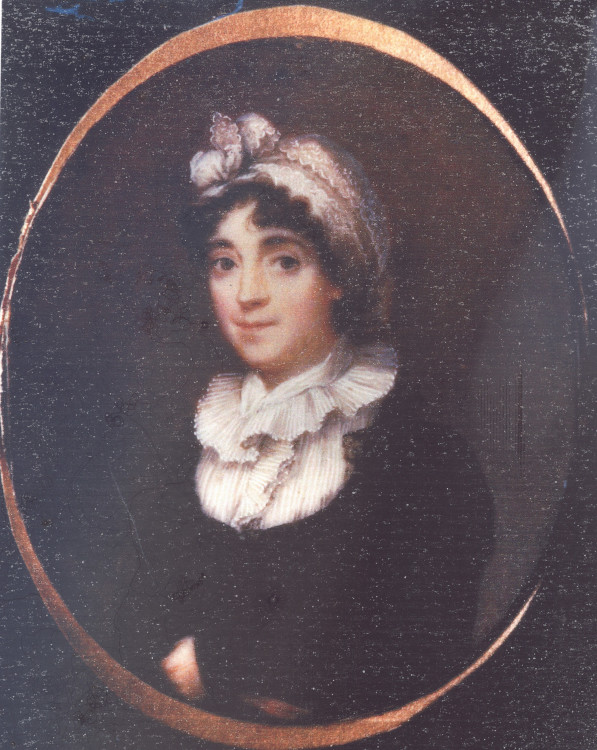
These portraits of Rev John Emra and his wife, Elizabeth Bastone Emra (née Blake) were kindly shared with us at our drop-in event on Troopers Hill in October 2022 by Martin. Martin had received these some years ago from a descendant of the Emras, who had said they were happy for them to be shared.


The Emra Church
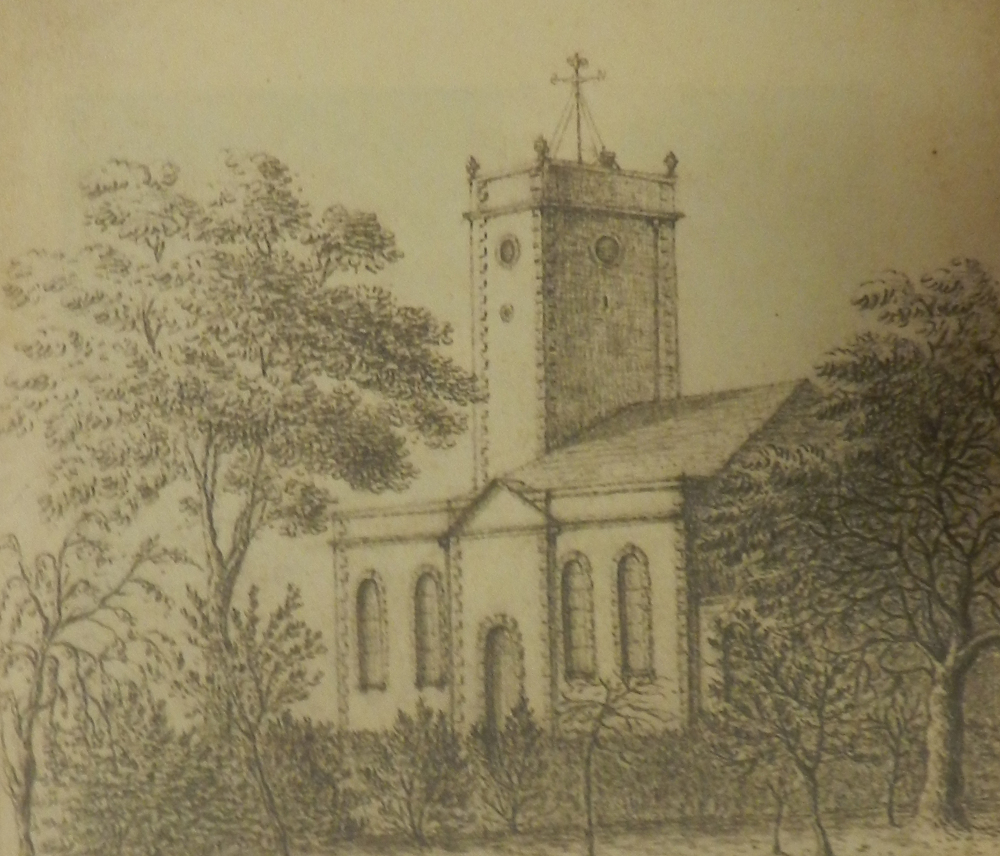 John Emra's church in St George was the first of three on the site of what is now St George's House on Church Drive off Church Road. The church was built between 1752 and 1756 for the new Parish that had been created in 1751 to serve the growing population of this part of Bristol.
John Emra's church in St George was the first of three on the site of what is now St George's House on Church Drive off Church Road. The church was built between 1752 and 1756 for the new Parish that had been created in 1751 to serve the growing population of this part of Bristol.
The vicarage was adjacent to the church next to Harvey's Lane. The drawing of the church shown here is believed to have been by a member of the Emra Family.
Following the death of Rev John Emra in 1842, the new vicar, Rev George Salt, decided that the church needed to be rebuilt apparently to make it 'more ecclesiastical'.
This second St George Church was designed by John Hicks and opened in 1846. The newspaper report on the opening ceremony (held on Tuesday 9th June) reports that one of the clergy attending stated that the church now really "looks something like a church should". The report describes the new church and compares it to the old one where Rev John Emra held services for 33 years:
"It will be remembered that the old building, which was erected in the year 1752, was a clumsily contrived affair, possessing no distinct architectural feature, but displaying a general jumble of styles, as if the architect had made it the medium of advertising the versatility of his genius."
The old church, with the exception of the tower, had been "razed to the ground" "The tower, which was formerly a plain square building, surmounted by four ungainly Grecian urns, has been completely altered in its appearance by the addition of buttresses, surmounted by four crocketed pinnacles, and an open parepet, and appropriate belfry windows &c.
The opening of the rebuilt church was less than three years after the death of Elizabeth 'The Country Parson's Daughter' and her life was remembered
"A carved freestone font has been presented to the church by Mr Marcus Holmes, as a momento of his amiable and talented lady, the daughter of the lamented Rev John Emra, the late Vicar of St George."
A watercolour the first church in 1823, by Hugh O'Neill, can be seen on the Council's mapping system. The chuch is also shown on the skyline in an 1826 drawing of the view from Arnos Court commissioned by GW Braikenridge.
The second church was destroyed by fire on 22nd December 1878. The replacement, third, church was demolished to make way for housing in 1976.
The history of the churches is described in more detail here and illustrations of the first and second churches are included our history of the Emra family.
Local historian, Dave Stephenson has also written about the St George Churches, his aritcles for the Bristol Times can be seen on our Memories page.
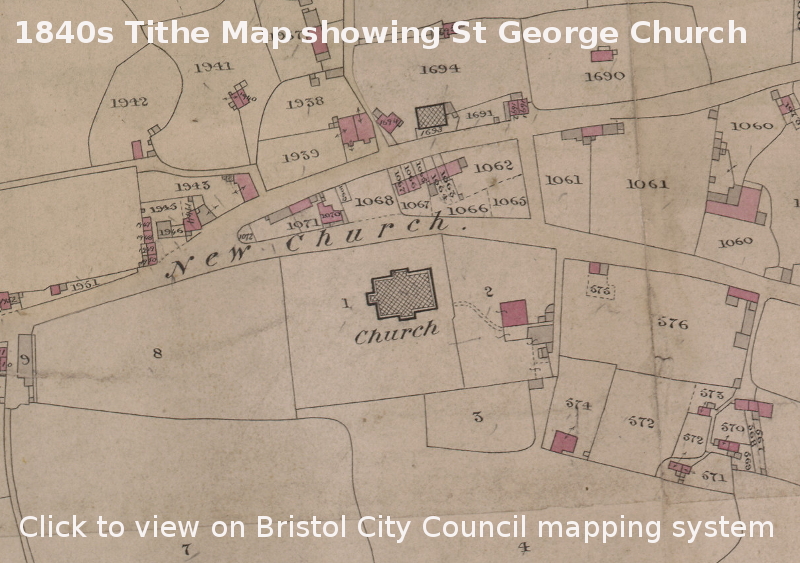

Little Elizabeth's View
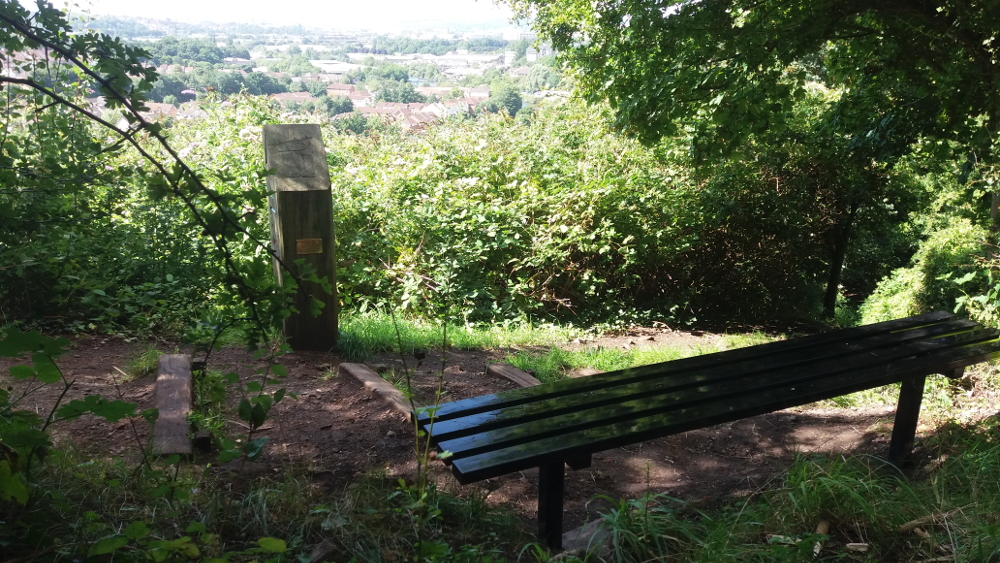 As the path through Troopers Hill Woods that forms part of the Woodland Trail leaves the nature reserve and enters the woodland there is a trail marker post and adjacent to it a bench. This is the location we call 'Little Elizabeth's View'.
As the path through Troopers Hill Woods that forms part of the Woodland Trail leaves the nature reserve and enters the woodland there is a trail marker post and adjacent to it a bench. This is the location we call 'Little Elizabeth's View'.
The carving on the post was inspired by Elizabeth's story.
The current bench was installed in August 2017 as a result of an appeal for funds launched by Friends of Troopers Hill after the previous bench had reached the end of its life.
As well as public donations, some of the funds for the bench came from the ALHA (Avon Local History & Archaeology) which was given as a thank you for our members leading a guided walk for them. A further donation from ALHA has been used to install a small plaque on the marker post with a reference to Elizabeth Emra.
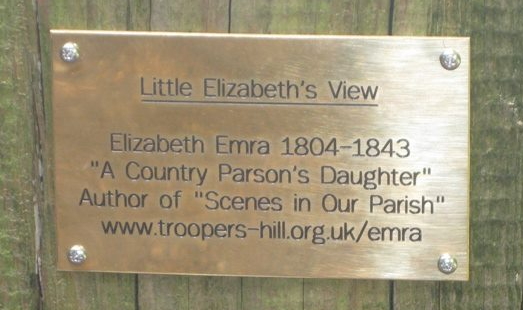

Inspiring Today's Generation
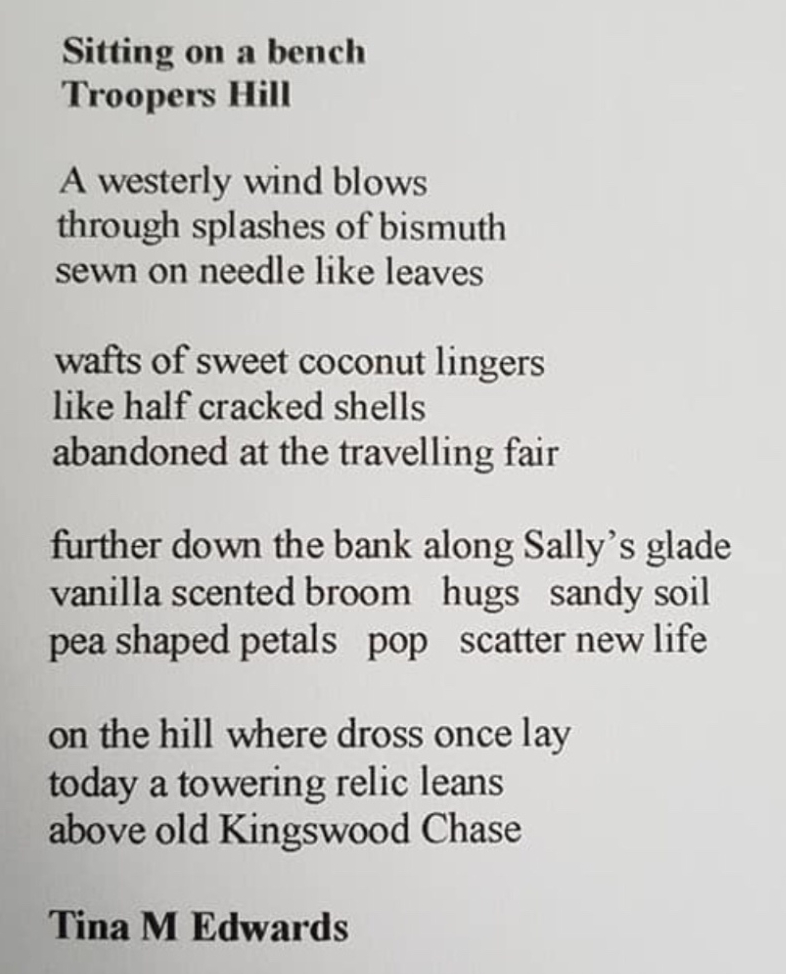 Nearly 200 years have passed since Elizabeth Emra wrote her books; but her words still have the power to inspire.
Nearly 200 years have passed since Elizabeth Emra wrote her books; but her words still have the power to inspire.
 Writer Tina M Edwards was inspired by reading to 'The Strawberry Feast' whilst sat upon Troopers Hill to write the poem that can be seen here.
Writer Tina M Edwards was inspired by reading to 'The Strawberry Feast' whilst sat upon Troopers Hill to write the poem that can be seen here.
 Local historian, Dave Stephenson, wrote an article about the Emra Family for the Bristol Times insert of the Bristol Post that was published in March 2025.
Local historian, Dave Stephenson, wrote an article about the Emra Family for the Bristol Times insert of the Bristol Post that was published in March 2025.
Meet the Emras - Dave Stephenson March 2025
 Elizabeth Emra and the Strawberry Feast feature in a radio documentary which is part of '12 Communities 1 Bristol' on BCfm radio. In the first part of the programme Alice Homewood, talks to our Rob Acton-Campbell about Elizabeth Emra's life - there is a link on our Memories page
Elizabeth Emra and the Strawberry Feast feature in a radio documentary which is part of '12 Communities 1 Bristol' on BCfm radio. In the first part of the programme Alice Homewood, talks to our Rob Acton-Campbell about Elizabeth Emra's life - there is a link on our Memories page
 Journalist Elly Roberts wrote about Little Elizabeth for the Bristol Cable in November 2017, you can read her article "Commemorating a pioneering St George author" here:
Journalist Elly Roberts wrote about Little Elizabeth for the Bristol Cable in November 2017, you can read her article "Commemorating a pioneering St George author" here:
Bristol Cable feature - Full text

Scenes in our Parish
by a Country Parson’s Daughter (Elizabeth Emra)
First Published in 1830 & 1832
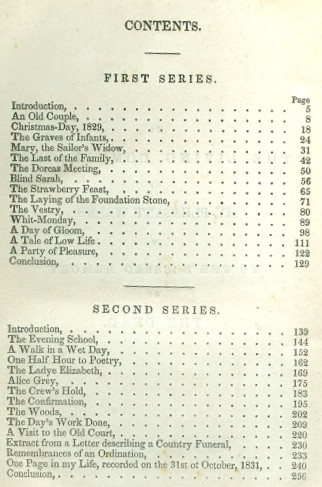 "the fairies of our forest foresook their haunts here, on the same day on which the first coal-pit was opened."
"the fairies of our forest foresook their haunts here, on the same day on which the first coal-pit was opened."
Scenes in our Parish gives a fascinating insight into life and death (mostly
death) in the 1830s in St George. It describes many of those who lived in
the Parish who Elizabeth visited and tried to help and comfort in her role
as the Parson’s daughter.
"It’s a little masterpiece" - Dave Stephenson, Bristol Times, March 2025
Elizabeth wrote the book in two parts (first & second series) with the first chapter dated 1829
and the last chapter describing the Bristol Riots of 30th October 1831 as
seen from St George. There is a date at the end of most chapters to show when it was written.
While St George is not mentioned, 'Crew's Hold' clearly refers to Crew's Hole and some other locations can be identified from the text.
The dates given also allow occasional links to actual events; for example the chapter "Laying the foundation stone" is dated 17 April 1830 and the description (and the distance Elizabeth walks) corresponds with newspaper reports on the laying of the foundation stone of Christ Church in Downend on Thursday 15th April 1830 after a procession from the Church of St James in Mangotsfield.
So it seems certain that Elizabeth was describing real people and real events. The lack of place names, and indeed the use of a pseudonym, was probably to avoid her friends & neighbours being identified.
Editions were published in both Britain and the United States from 1832 onwards containing both parts. Below are quotes from two of the chapters that most relate to Troopers Hill and Crews Hole.
Scenes in Our Parish, by a Country Parson’s Daughter can be downloaded from:
• First Series published 1830 - tinyurl.com/EmraScenes1
• Second Series published 1832 - tinyurl.com/EmraScenes2
• 1833 American version of Scenes in our Parish - http://tinyurl.com/emra1833
You can also find reproductions for sale on various internet sites as 'print on demand'. Occasionally original editions are available from second-hand book sellers either in the UK or in the US.

Scenes in our Parish Chapter - The Strawberry Feast
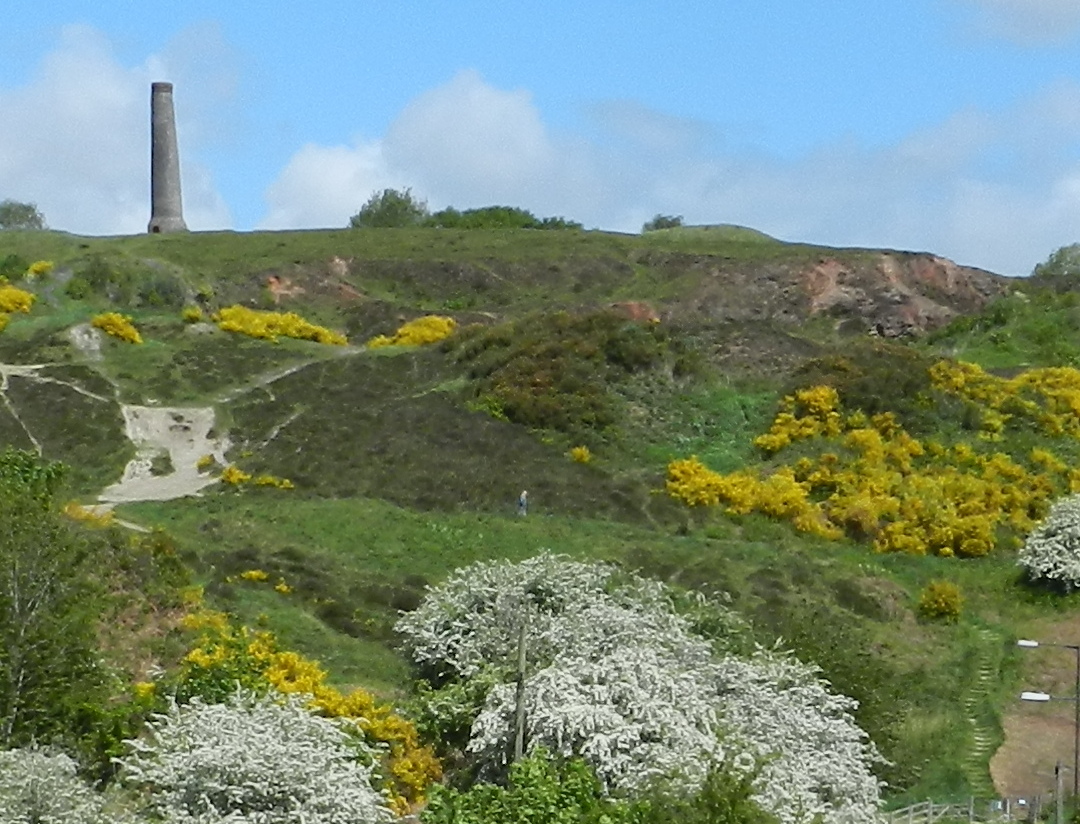 The quote that links Elizabeth Emra to Troopers Hill is taken from 'The Strawberry Feast' which is in the first part of Scenes in our Parish and dated 30th March 1830.
The quote that links Elizabeth Emra to Troopers Hill is taken from 'The Strawberry Feast' which is in the first part of Scenes in our Parish and dated 30th March 1830.
“the barren and quarried hill, with its yellow spots of gorse and
broom, and its purple shade of heath, raising itself above the dark
heaps of dross on our own side; and then the river, the beautiful, soft
flowing river that we have all loved so well, laving as kindly our rough
and barren banks, and holding its pure mirror to us, as truly as to the
embellished and fertile scenery on the other side; and how clearly we
saw every reversed image of the trees in the little copse-wood
beyond…”
[Dictionary definition of dross: ‘The scum thrown off from metals in
smelting’]
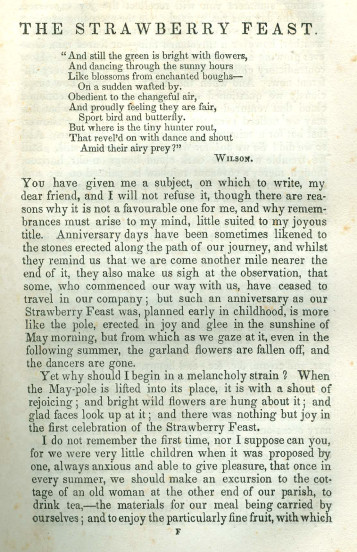 But that is towards the end of the story, first there is concern about the weather for their planned festivities:
But that is towards the end of the story, first there is concern about the weather for their planned festivities:
“once in every summer, we would make an excursion to the cottage of
an old woman, to drink tea and to enjoy the particularly fine fruit,
with which her hilly and sunny garden would supply us.”
“On the preceding evening, how anxiously we watched the sunset, and
foretold fine weather, however it threatened rain, - or feared rain,
however glowing and glorious the setting sun might be.”
“it was not till old Betty became too infirm to receive us, and the
meeting was adjourned to the house below the hanging gardens,
beside the river, that we found out all the pleasures of that evening.
We could not ride there to be sure, but you know how lovely the walk
is, down the fields on a summer’s evening and through that deep and
stony lane.”
“The scene of our festivities was a large lofty room in an awkwardly
built house, designed originally for the agent of a certain concern
which failed as many other concerns have done; so that for years the
extensive works connected with it have lain void…”
“the great house was let to a poor but very respectable family, who
thankfully allowed the use of their large room on these occasions. It
was a curious old place altogether; but its chief charm was the
garden, built according to the taste of the times sixty years ago.
Perhaps I should have said laid out, but there were so many flights of
stone steps leading through brick arches, to broad straight walks one
above another; and so many square summer-houses with stonewalls
and square doors and windows, that your first thought was of the
buildings; and stiff and formal enough it must have looked when it
was first planned. But now that the brick arches were falling into
decay, and ornamented with faithful wall-flower, and wreathed and
half covered with ivy; … it had become interesting from its appearance
of antiquity.”
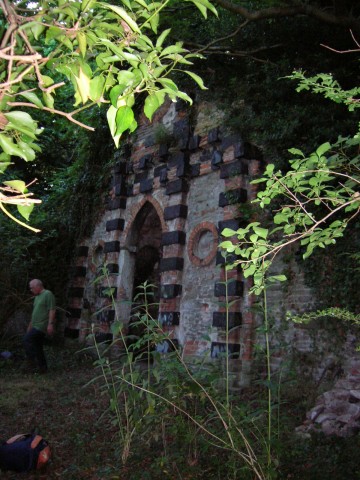 “For when we reached the top of the last flight of tottering steps, we
found ourselves in a wilderness, where, up the steep side of the hill,
grew untrimmed bushes of red a white roses, tangled with wild
bramble, and over topped by stately old pear trees.”
“For when we reached the top of the last flight of tottering steps, we
found ourselves in a wilderness, where, up the steep side of the hill,
grew untrimmed bushes of red a white roses, tangled with wild
bramble, and over topped by stately old pear trees.”
“many a frock was torn, and many a tumble we met with, before we
reached the arched summer house, with the bath in the middle, at the
very top of the hill. And oh! what a view we had then. The steep and
singular garden up which we had just climbed; the old buildings and
tall chimneys clustered together so very far below us; the barren and
quarried hill, with its yellow spots of gorse and broom, and its purple
shade of heath,….."
Few buildings are left from Elizabeth's time in St George, but surprisingly the 'summer house with the bath in the middle' is one of them. You can see it on a video of a visit made by Friends of Troopers Hill in 2005.
Bath House Video >>

Scenes in our Parish Chapter - The Crew’s Hold May 31, 1831
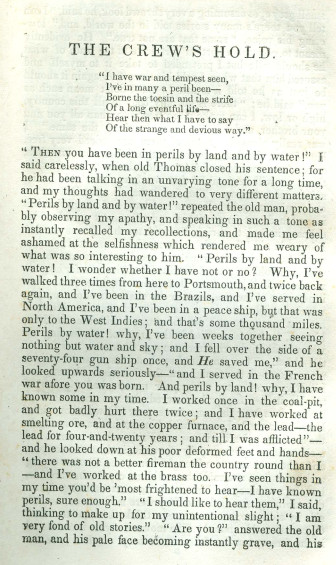 Elizabeth is speaking to ‘Old Thomas’ about ‘Crews Hold’ and asks if he
can remember how the sailors used to come up here to hide from the
pressgang.
Elizabeth is speaking to ‘Old Thomas’ about ‘Crews Hold’ and asks if he
can remember how the sailors used to come up here to hide from the
pressgang.
“the people, for the most part, liked the sailors, and harboured them,
and used the officers of the pressgang very ill.”
Elizabeth mentions that she has heard about taking them down the coal
pits. Old Thomas confirms that they did, he goes on:
“I’ll tell ye something worse than that they did once, they took the
King’s officers, and carried them blindfold down to the copper furnace.
They tore down the door, and made them look down into the furnace,
and threatened to throw them in if they ever came that way again.”
On the name…
“in time to come, when a generation or two more have past, people will
not know the meaning of the name given to this part of the parish –
The Crew’s Hold – for it has already degenerated into the unmeaning
word Screwshole. It is a singularly wild and poor part, yet we feel now
not the smallest fear; and indeed, I don’t think there is anybody here
now, that would hurt a child.”
Elizabeth describes a cottage near the river where she used to visit
Henry and Sarah Curtis when she was young. She says the house and the
area around it are now much altered.
“The precipitous bank, beyond it, where there used to grow gaze [???],
and furze [gorse] and broom, is excavated into a very large stone
quarry. There are noble masses of stone, displaying every variety of
colour, from pale brown to deep red, and from cold neutral tint to
bright purple.”
“they have discovered, that the whole hill side can afford stone, and
soon I suppose it will be one huge quarry.
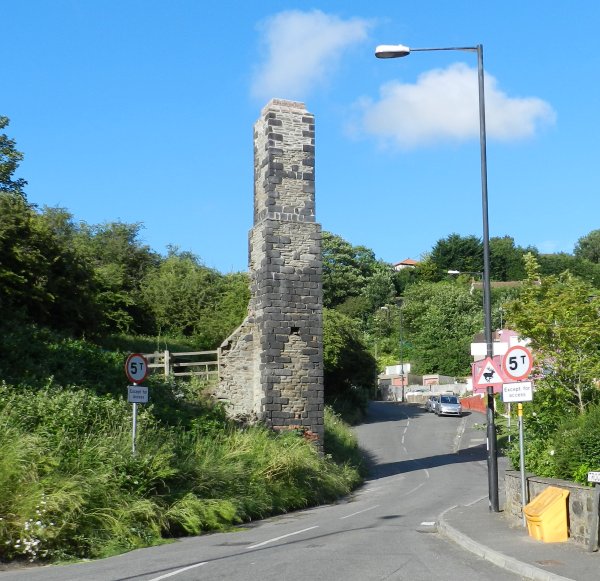 They have done worse than this.
They have built a steam-engine for raising coal on a spot, which we
used to think quiet and pleasant; and where, until then we could
gather woodbine and blue violets.”
They have done worse than this.
They have built a steam-engine for raising coal on a spot, which we
used to think quiet and pleasant; and where, until then we could
gather woodbine and blue violets.”
Of the house she says:
“it was unlike all other houses that we had ever seen. It consisted but
of one room on the ground floor, from whose corners a bed room,
pantry, and the little sitting-room were partitioned off. There was a
large flue in the middle of the ceiling, at which we used to gaze up in
wonder; and I remember old Sarah’s trying to describe to us the
apparatus which once belonged to it, and which was used, as far as I
understand, for trying the qualities of ore.”
The house by the river must have been part of the old copper smelting
works “The Cupolas”. The quarry is probably the area of Bull Lane and the
steam-engine the one at the bottom of Troopers Hill Road.
Since Elizabeth was born in 1804 and this is written in 1831, it would date
the Engine house at around 1820. This fits with old maps since it is not
shown in 1803 but is there in 1845.
You can read about copper smelting and coal mining in the area on our History page.
Elizabeth also adds that Sarah Curtis "had once lived in a larger abode, having many years before we knew her been mistress of the white house - the resort of the rebellious sailors". More about the White House >>.

Poem - 'The Snowdrop’s Call' - published in 1830 in Forget-Me-Not
This wonderful poem, was published in the 1830 edition of the literary annual, Forget-Me-Not, appearing on page 168. It was published under Elizabeth's real name, rather than a pseudonym.
A scan of the original and more information can be seen here thanks to the Digital Victorian Periodical Poetry Project.
The Snowdrop’s Call,
By Miss Elizabeth Emra
Who else is coming?— There’s sunshine here!
Ye would strew the way for the infant year :
The frost-winds blow on the barren hill,
And icicles hang in the quarry still ;
But sunny, and shelter’d, and safe, are we,
In the moss at the foot of the sycamore tree.
Are ye not coming? the first birds sing ;
They call to her bowers the lingering Spring ;
And, afar to his home near the north pole-star,
Old Winter is gone in his snow-cloud car ;
And the storms are past, and the sky is clear,
And we are alone, sweet sisters! here.
Will ye not follow? Ye safe shall be
In the green moss under the sycamore tree.
And, oh! there is health in the clear cold breeze,
And a sound of joy in the leafless trees ;
And the sun is pale, yet his pleasant gleam :
Has waken’d the earth, and unchain’d the stream ;
And the soft west-wind, oh, it gently blows !
Hasten to follow, pale lady Primrose !
And Hyacinth graceful, and Crocus gay,
For we have not met this many a day.
Follow us, follow us! follow us then,
All ye whose home is in grove or glen.
Why do ye linger? Who else is coming,
Now Spring is awaked with the wild bees’ humming ?
snowdrop photo © Katarzyna Szudy

'Realities of Life' - published in 1838
by Mrs Elizabeth Holmes (née Emra)
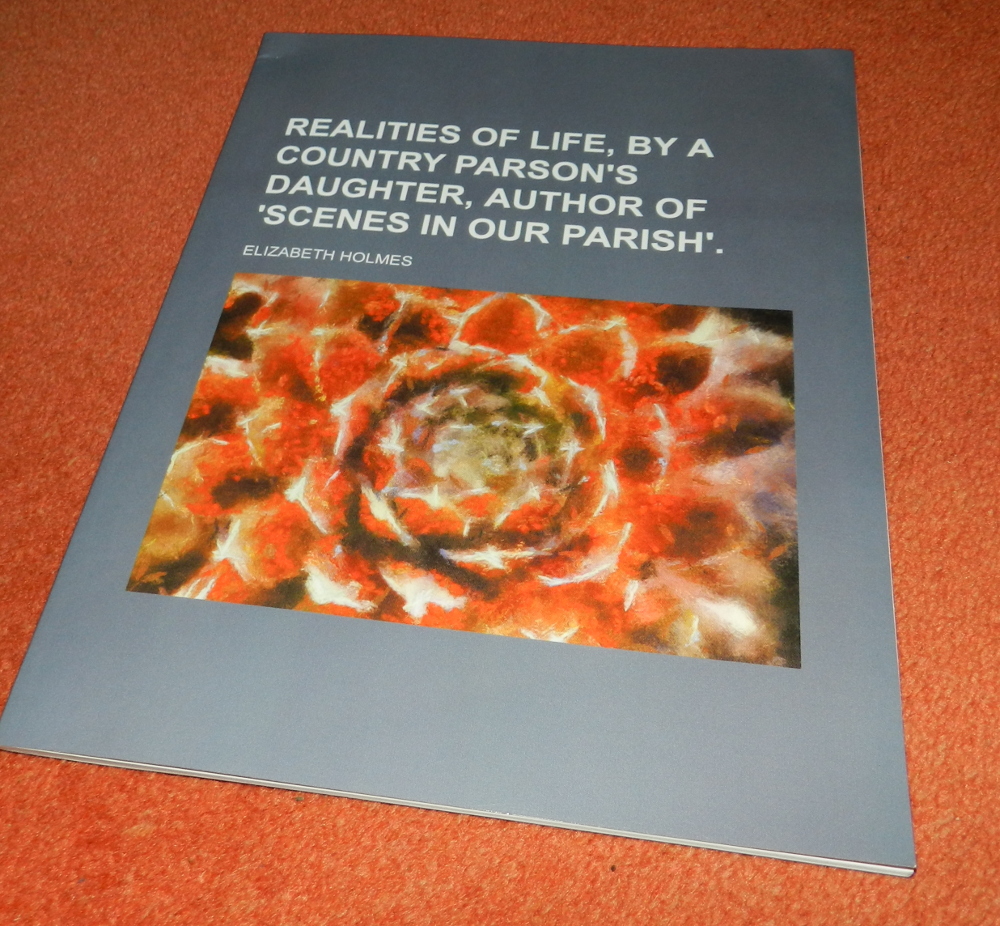 'Realities of Life' which was published in 1838 also has some references to St George; this can be found on Google books at: tinyurl.com/emra1838 and again is available as a 'print on demand' reproduction from some internet book sellers.
'Realities of Life' which was published in 1838 also has some references to St George; this can be found on Google books at: tinyurl.com/emra1838 and again is available as a 'print on demand' reproduction from some internet book sellers.
Of particular interest are Elizabeth's comments about the building of the new railway in St Anne's and the tourists coming to Crews Hole to catch the ferry to go and see it.
"who would pass winter in such a lonesome place? - A lonesome place? I was almost
going to say, I wish it were lonesome now."
"But see the number of huts, perched on the rocky banks of Strawberry Lane; and look
down at the congregated rows of mean houses, along the towing path, each alas! with
its well-accustomed beer-shop. And hear that throng of people, hallooing for the boat,
at what used to be our quiet ferry."
"Ah! if it be the Sabbath day, the throng is but the greater. They are going to keep
holiday, by visiting the new rail-road, which has bought here such an influx of
disorderly strangers, and such an awful accumulation of our list of accidents: and say
if we shall ever have to complain of "lonesomeness" again."

A Description of Troopers Hill
from 'Things New and Old' - published in 1839
by 'A District Visitor' (Lucy Emra)
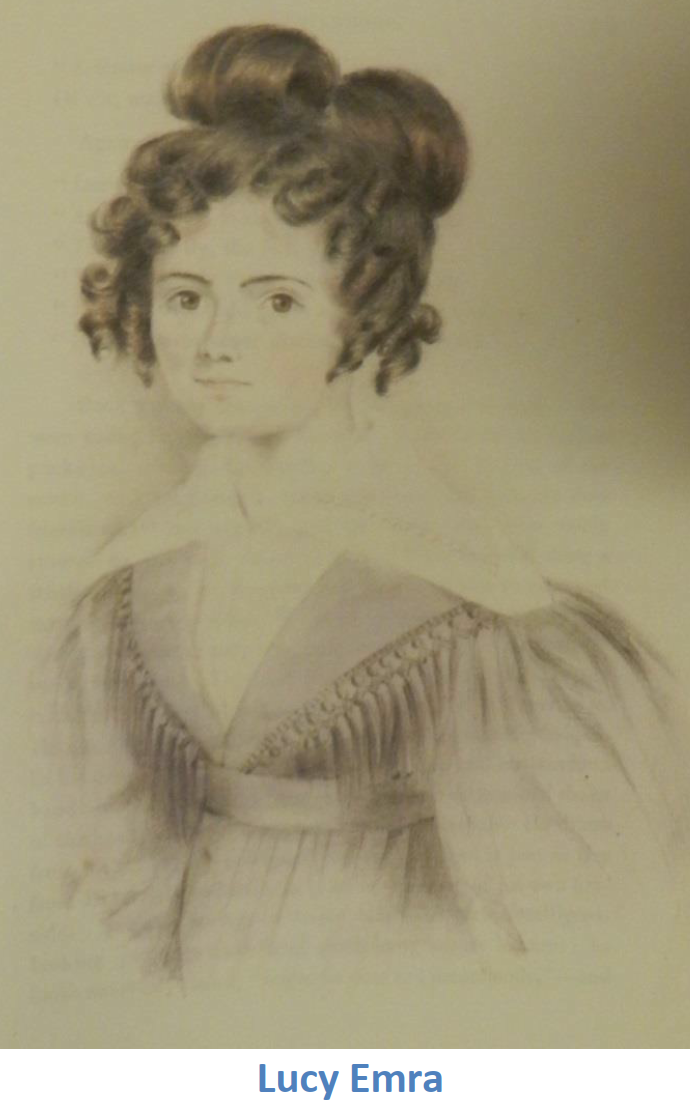 The wonderful description below is the opening of the chapter 'Patience in Tribulation' in 'Things New and Old' written by Lucy Emra in 'St George's Vicarage, Gloucestershire'. The remainder of the chapter is the story of Ann G.... who lived in one of the cottages that could be seen from the Hill.
The wonderful description below is the opening of the chapter 'Patience in Tribulation' in 'Things New and Old' written by Lucy Emra in 'St George's Vicarage, Gloucestershire'. The remainder of the chapter is the story of Ann G.... who lived in one of the cottages that could be seen from the Hill.
"Among our pleasant walks, there is not one
more pleasant than that across the hill that leads
to the banks of the Avon.
The view from that
hill we have seen at all seasons of the year; when
the winter has stripped the trees, and covered
every thing with its snowy mantle; when the
soft spring or autumn has shed its chastened beauties over the landscape; during the glowing heats
of summer, when the hill is ornamented with
beautiful purple heath and golden broom; we
have admired the scene in the bright glories of
the noon-day; in the calm light of morning and
evening, and the still softer light of the moon; and
always it is lovely.
On one side is our home and our church; Bristol at a distance with its many
steeples; the river Avon, and the fertile fields of
Somersetshire; on another side, are a number of
humble dwellings, scattered over a wild, and once
well wooded hill, now divided into little gardens,
and intersected by many paths."
Things New & Old on Google Books >>
Drawing of Lucy Emra from extra-illustrated version of 'Recollections of Childhood' by ‘Primogenita’, held in the Somerset Archive (ref
DD/UK/58)

A Remembrancer of Old Friends
Unpublished works by Elizabeth, Martha, Lucy & John
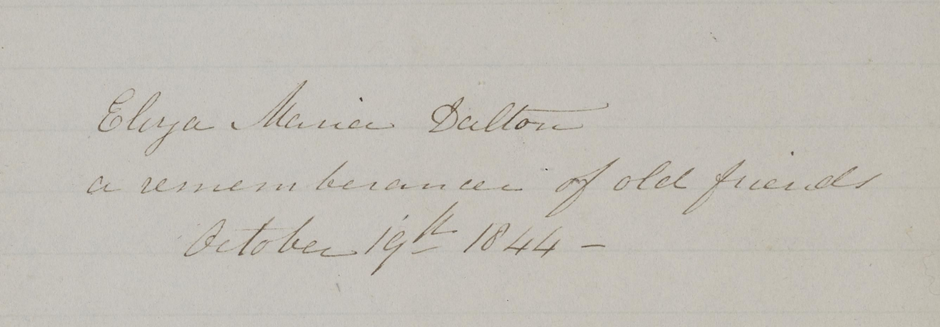
The University of Pennsylvania Penn Libraries hold in their collection ‘A remembrancer of old friends’ a handwritten notebook which belonged to Eliza Maria Dalton.
The book is described as: A slim ruled volume with a plaid green and gold paper cover comprising copied poems and elegies with Christian themes. Written on the first page of the volume is "Eliza Maria Dalton a rememberancer [sic] of old friends, October 19th 1844.”
This book has been digitised and included in the ‘Colenda Digital Repositary’ >>
The Remembrancer is handwritten and includes poems and texts by Elizabeth, Martha & Lucy Emra as well as their brother, John, and his daughter Maria Anne Emra.
Susan Acton-Campbell, Chair of Friends of Troopers Hill has transcribed the works in the book that are otherwise unpublished.
These transcribed texts are reproduced in the document below with brief introductions giving more information and context.
A Remembrancer of Old Friends - Transcribed by Susan Acton-Campbell

More Information
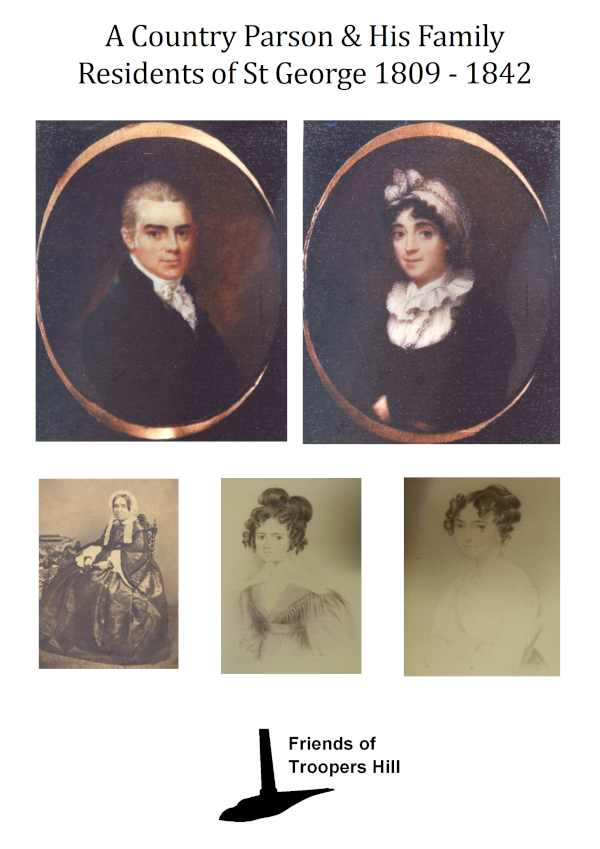 Rob Acton-Campbell has put together a pdf telling the story of the Emra family with some of the images from the extra-illustrated books.
Rob Acton-Campbell has put together a pdf telling the story of the Emra family with some of the images from the extra-illustrated books.
This also sets out the relationship of Rev John Emra, through his mother, to the slave-owning Manning family in St Kitts.
Also included are lists of the the known published works of Elizabeth and her brother and sisters.
There are also two documents with more details of Elizabeth and the Holmes family.
"Such be your lot, my kind and patient companion; we may perhaps, meet again. If not, assure yourself that you bear with you my thanks, and my best wishes. - Good night."
 Martha, had also published a book in 1840, ‘Recollections of Childhood or Sally the faithful nurse’ under the pseudonym ‘Primogenita’ – reflecting the fact that she was the oldest child. This book describes the life of the family as her father served at different chuches as Curate and then in St George as vicar. The book is available on Google Books or can be purchased as a reproduction.
Martha, had also published a book in 1840, ‘Recollections of Childhood or Sally the faithful nurse’ under the pseudonym ‘Primogenita’ – reflecting the fact that she was the oldest child. This book describes the life of the family as her father served at different chuches as Curate and then in St George as vicar. The book is available on Google Books or can be purchased as a reproduction.
 Elizabeth's baptism was recorded by her father on 17th October 1815, at the same time as her two sisters who had also been born while the family was living in Bristol; John Emra added a note to the register - "Memo: These my three Daughters, namely Lucy born 19th September 1799, Sarah-Grey born 21st May 1802, and Elizabeth born 20th November 1804 were privately baptized in their infancy, but through inadvertence their Baptisms were not at that time registered"
Elizabeth's baptism was recorded by her father on 17th October 1815, at the same time as her two sisters who had also been born while the family was living in Bristol; John Emra added a note to the register - "Memo: These my three Daughters, namely Lucy born 19th September 1799, Sarah-Grey born 21st May 1802, and Elizabeth born 20th November 1804 were privately baptized in their infancy, but through inadvertence their Baptisms were not at that time registered"
 After their marriage Elizabeth and Marcus lived in ‘Homefield Cottage’
next to the Church and the vicarage; "the shadow of my father's trees Fall on my husband's home". Her first child, a girl, was born on 6th July 1834. One of Elizabeth's children died as an infant (John at only 2 days old in August 1838), but by the time of the 1841 census she and Marcus were living at Homfield with five children, Ann (aged 6), Henry (5), Agnes (3), John Emra (2) & Herbert (5 months).
After their marriage Elizabeth and Marcus lived in ‘Homefield Cottage’
next to the Church and the vicarage; "the shadow of my father's trees Fall on my husband's home". Her first child, a girl, was born on 6th July 1834. One of Elizabeth's children died as an infant (John at only 2 days old in August 1838), but by the time of the 1841 census she and Marcus were living at Homfield with five children, Ann (aged 6), Henry (5), Agnes (3), John Emra (2) & Herbert (5 months).

 The story of the Emra family is also featured on the Bridging Histories website:
The story of the Emra family is also featured on the Bridging Histories website: John Emra's church in St George was the first of three on the site of what is now St George's House on Church Drive off Church Road. The church was built between 1752 and 1756 for the new Parish that had been created in 1751 to serve the growing population of this part of Bristol.
John Emra's church in St George was the first of three on the site of what is now St George's House on Church Drive off Church Road. The church was built between 1752 and 1756 for the new Parish that had been created in 1751 to serve the growing population of this part of Bristol.
 As the path through Troopers Hill Woods that forms part of the Woodland Trail leaves the nature reserve and enters the woodland there is a trail marker post and adjacent to it a bench. This is the location we call 'Little Elizabeth's View'.
As the path through Troopers Hill Woods that forms part of the Woodland Trail leaves the nature reserve and enters the woodland there is a trail marker post and adjacent to it a bench. This is the location we call 'Little Elizabeth's View'.

 Nearly 200 years have passed since Elizabeth Emra wrote her books; but her words still have the power to inspire.
Nearly 200 years have passed since Elizabeth Emra wrote her books; but her words still have the power to inspire. "the fairies of our forest foresook their haunts here, on the same day on which the first coal-pit was opened."
"the fairies of our forest foresook their haunts here, on the same day on which the first coal-pit was opened." The quote that links Elizabeth Emra to Troopers Hill is taken from 'The Strawberry Feast' which is in the first part of Scenes in our Parish and dated 30th March 1830.
The quote that links Elizabeth Emra to Troopers Hill is taken from 'The Strawberry Feast' which is in the first part of Scenes in our Parish and dated 30th March 1830.
 But that is towards the end of the story, first there is concern about the weather for their planned festivities:
But that is towards the end of the story, first there is concern about the weather for their planned festivities:
 Elizabeth is speaking to ‘Old Thomas’ about ‘Crews Hold’ and asks if he
can remember how the sailors used to come up here to hide from the
pressgang.
Elizabeth is speaking to ‘Old Thomas’ about ‘Crews Hold’ and asks if he
can remember how the sailors used to come up here to hide from the
pressgang.
 They have done worse than this.
They have built a steam-engine for raising coal on a spot, which we
used to think quiet and pleasant; and where, until then we could
gather woodbine and blue violets.”
They have done worse than this.
They have built a steam-engine for raising coal on a spot, which we
used to think quiet and pleasant; and where, until then we could
gather woodbine and blue violets.” 'Realities of Life' which was published in 1838 also has some references to St George; this can be found on Google books at: tinyurl.com/emra1838 and again is available as a 'print on demand' reproduction from some internet book sellers.
'Realities of Life' which was published in 1838 also has some references to St George; this can be found on Google books at: tinyurl.com/emra1838 and again is available as a 'print on demand' reproduction from some internet book sellers. The wonderful description below is the opening of the chapter 'Patience in Tribulation' in 'Things New and Old' written by Lucy Emra in 'St George's Vicarage, Gloucestershire'. The remainder of the chapter is the story of Ann G.... who lived in one of the cottages that could be seen from the Hill.
The wonderful description below is the opening of the chapter 'Patience in Tribulation' in 'Things New and Old' written by Lucy Emra in 'St George's Vicarage, Gloucestershire'. The remainder of the chapter is the story of Ann G.... who lived in one of the cottages that could be seen from the Hill.

 Rob Acton-Campbell has put together a pdf telling the story of the Emra family with some of the images from the extra-illustrated books.
Rob Acton-Campbell has put together a pdf telling the story of the Emra family with some of the images from the extra-illustrated books.